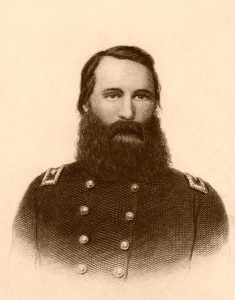In mid-February 1863, most of Confederate Lieutenant General James Longstreet’s corps was moved south by rail. Confederate President Jefferson Davis made three purposes clear to General Longstreet — 1) Longstreet was to keep himself able to cover Richmond in case the Union landed troops at Fort Monroe and moved up the James-York Peninsula again. 2) Be able to move back to Fredericksburg if Major General Joseph Hooker moved. 3) Push the Union troops back to their bases, capture any of those ports if possible, gather all the provisions and volunteers possible in the area, which had been under Union occupation for almost a year. Longstreet had to be careful not to get drawn into pointlessly bloody battles in this little campaign. This may be why General Robert E. Lee chose Longstreet over Stonewall Jackson, who had more experience in independent operations. Longstreet’s Tidewater Operations battles were inconclusive and resulted in total estimated casualties of 1,160 for the entire siege.
Norfleet House/Suffolk (April 13-15, 1863) – In cooperation with Confederate General Daniel H. Hill’s advance on Washington, North Carolina, Lieutenant General James Longstreet with Generals John Hood’s and George Pickett’s divisions besieged the Union garrison at Suffolk commanded by Brigadier General John Peck. The Union works were formidable and manned by 25,000 men, as opposed to Longstreet’s 20,000. On April 13th, the Confederate troops pushed their left flank to the Nansemond River and constructed a battery on Hill’s Point, closing the garrison to Union shipping. On April 14th, Union gunboats attempted to run the Norfleet House batteries slightly upstream, but Mount Washington was crippled. At the same time, the Federals constructed batteries to command the Confederate works at Norfleet House. On April 15th, these batteries were unmasked and opened fire, driving the Confederates out of this critical position. The number of casualties is unknown.
Hill’s Point/Suffolk (April 11-May 4, 1863) – Also known as the Battle of Hill’s Point, this engagement occurred in Suffolk, Virginia. On April 19th, a Union infantry force landed on Hill’s Point at the confluence of the Nansemond River’s forks. This amphibious force assaulted Fort Huger from the rear, quickly capturing its garrison, thus reopening the river to Union shipping. On April 24th, Brigadier General Michael Corcoran’s Union division mounted a reconnaissance-in-force from Fort Dix against Major General George E. Pickett’s extreme right flank. The Federals approached cautiously and were easily repulsed. On April 29th, General Robert E. Lee directed Longstreet to disengage from Suffolk and rejoin the Army of Northern Virginia at Fredericksburg. By May 4th, the last of Longstreet’s command had crossed the Blackwater River en route to Richmond. The inconclusive battle resulted in estimated Union casualties of 17 and 153 Confederate.
Compiled and edited by Kathy Alexander/Legends of America, updated February 2022.
Also See:
Sources:
Battlefields.org
National Park Service Battle Descriptions (no longer available online)
National Park Service Civil War

